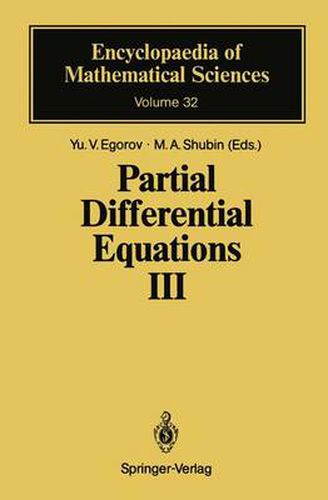Readings Newsletter
Become a Readings Member to make your shopping experience even easier.
Sign in or sign up for free!
You’re not far away from qualifying for FREE standard shipping within Australia
You’ve qualified for FREE standard shipping within Australia
The cart is loading…






This title is printed to order. This book may have been self-published. If so, we cannot guarantee the quality of the content. In the main most books will have gone through the editing process however some may not. We therefore suggest that you be aware of this before ordering this book. If in doubt check either the author or publisher’s details as we are unable to accept any returns unless they are faulty. Please contact us if you have any questions.
,h In the XIX century, mathematical physics continued to be the main source of new partial differential equations and ofproblems involving them. The study ofLaplace’s equation and ofthe wave equation had assumed a more systematic nature. In the beginning of the century, Fourier added the heat equation to the aforementioned two. Marvellous progress in obtaining precise solution repre- sentation formulas is connected with Poisson, who obtained formulas for the solution of the Dirichlet problem in a disc, for the solution of the Cauchy problems for the heat equation, and for the three-dimensional wave equation. The physical setting ofthe problem led to the gradual replacement ofthe search for a general solution by the study of boundary value problems, which arose naturallyfrom the physics ofthe problem. Among these, theCauchy problem was of utmost importance. Only in the context of first order equations, the original quest for general integralsjustified itself. Here again the first steps are connected with the names of D'Alembert and Euler; the theory was being intensively 1h developed all through the XIX century, and was brought to an astounding completeness through the efforts ofHamilton, Jacobi, Frobenius, and E. Cartan. In terms of concrete equations, the studies in general rarely concerned equa- tions of higher than second order, and at most in three variables. Classification ‘h ofsecond orderequations was undertaken in the second halfofthe XIX century (by Du Bois-Raymond). An increase in the number of variables was not sanc- tioned by applications, and led to the little understood ultra-hyperbolic case.
$9.00 standard shipping within Australia
FREE standard shipping within Australia for orders over $100.00
Express & International shipping calculated at checkout
This title is printed to order. This book may have been self-published. If so, we cannot guarantee the quality of the content. In the main most books will have gone through the editing process however some may not. We therefore suggest that you be aware of this before ordering this book. If in doubt check either the author or publisher’s details as we are unable to accept any returns unless they are faulty. Please contact us if you have any questions.
,h In the XIX century, mathematical physics continued to be the main source of new partial differential equations and ofproblems involving them. The study ofLaplace’s equation and ofthe wave equation had assumed a more systematic nature. In the beginning of the century, Fourier added the heat equation to the aforementioned two. Marvellous progress in obtaining precise solution repre- sentation formulas is connected with Poisson, who obtained formulas for the solution of the Dirichlet problem in a disc, for the solution of the Cauchy problems for the heat equation, and for the three-dimensional wave equation. The physical setting ofthe problem led to the gradual replacement ofthe search for a general solution by the study of boundary value problems, which arose naturallyfrom the physics ofthe problem. Among these, theCauchy problem was of utmost importance. Only in the context of first order equations, the original quest for general integralsjustified itself. Here again the first steps are connected with the names of D'Alembert and Euler; the theory was being intensively 1h developed all through the XIX century, and was brought to an astounding completeness through the efforts ofHamilton, Jacobi, Frobenius, and E. Cartan. In terms of concrete equations, the studies in general rarely concerned equa- tions of higher than second order, and at most in three variables. Classification ‘h ofsecond orderequations was undertaken in the second halfofthe XIX century (by Du Bois-Raymond). An increase in the number of variables was not sanc- tioned by applications, and led to the little understood ultra-hyperbolic case.